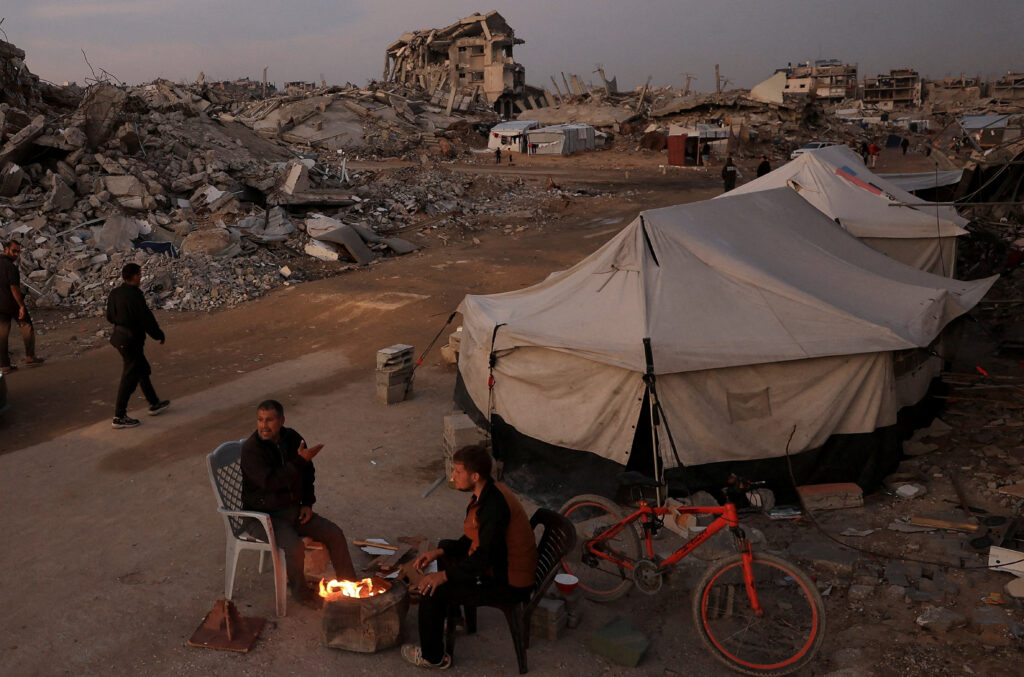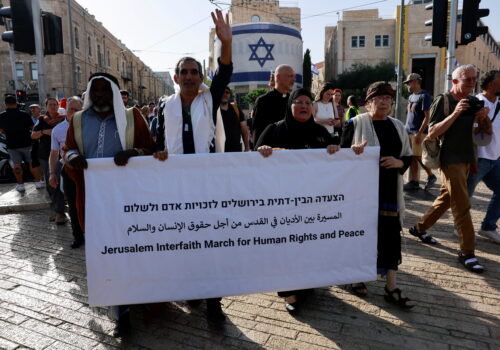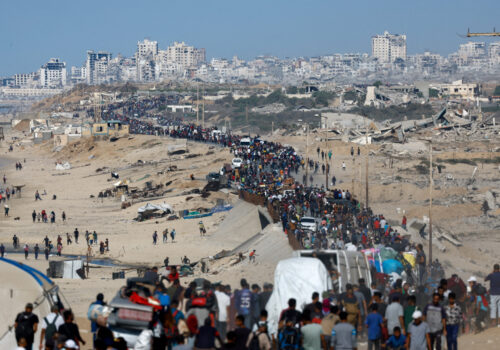This week’s visit by Saudi Crown Prince Mohammed bin Salman to Washington comes at a pivotal moment for the Gaza cease-fire. Nearly every actor in the region is exhausted, distrustful, and bracing for instability. The cease-fire exists on paper, but the political, economic, humanitarian, and security scaffolding required to sustain it does not. That vacuum is becoming increasingly dangerous. Without a coherent stabilization structure, the current mess of competing plans, fragmented chains of authority, and ad hoc security arrangements will harden into the kind of dysfunction that has historically made Gaza ungovernable.
Gaza and the wider region cannot afford another cycle of collapse. Right now, US President Donald Trump has an opportunity to prevent such a collapse. To do so, he will need to help guarantee international financial assistance for Gaza, which will allow vital humanitarian and preparatory activities to continue in the Strip. He will also need to help consolidate civilian and military operations in Gaza—before Hamas has any more time to reassert its power in the vacuum.
If used well, this week’s discussions in Washington can give the cease-fire a realistic chance of holding and shape the framework for Gaza’s postwar transition. Trump and the crown prince should start by announcing a Gaza stabilization fund, which would send an immediate signal that the cease-fire is tied to real resources and political ownership. Such an announcement, especially if backed by the United Arab Emirates, would reinforce humanitarian operations, support the cease-fire, and strengthen political confidence among Israelis and Palestinians alike.
Saudi funding would go a long way toward helping build out Trump’s peace plan, though without a clear path to a two-state solution, Riyadh will be limited in its engagement. With Saudi and Emirati funding in place, the United States could then push ahead alongside both countries in creating a more cohesive plan for implementation.
On Monday, the United Nations Security Council passed a resolution to establish a Trump-led “Board of Peace” and an International Stabilization Force (ISF) in Gaza, but the resolution risks becoming another hollow diplomatic instrument unless the operational aspects are clarified. I am told that several US entities are advancing plans in parallel, including Special Envoy Steve Witkoff’s team, State Department bureaus, the US embassy in Jerusalem, and US Central Command teams working through the US-led Civil-Military Coordination Center in southern Israel. No unified plan has been approved. In situations like this, there is typically supposed to be a political lead and a military lead, but neither has been formally named. Disputes over responsibilities, sequencing, and authority have led to decision paralysis.
It is essential for the ISF to have a single, empowered command structure. Humanitarian corridors, policing, border security, disarmament benchmarks, and reconstruction logistics cannot be coordinated through multiple chains of command. There is broad recognition from those I’ve spoken to in the field and in Washington that only a senior commander with regional experience can create the required coherence for the military track. Four-star General Erik Kurilla, who recently retired after heading US Central Command, is well placed for this role. He is trusted by Israel, respected in Gulf capitals, and already engaged in the coordination mechanisms tied to Gaza. If Trump were to designate Kurilla the lead commander, it would ensure that the State Department and the Department of Defense operate under a single mandate, that contractors inside Gaza respond to a unified chain of command, and that the civilian lead’s office remains connected to field operations rather than running parallel planning efforts.
This lack of clarity also affects international planning. Multiple reconstruction plans are circulating simultaneously, including the Palestinian Authority’s newly released 173-page proposal and ideas coming from Arab capitals. None provides an integrated humanitarian–security–governance architecture that can operate immediately. Gaza needs functioning essential services, basic civil order, and medical stabilization. Water distribution, sanitation, waste removal, emergency response capacities, and primary healthcare are equally vital for public confidence and the survival of the cease-fire.
A new Saudi- and Emirati-backed stabilization fund could help address several urgent needs. These include clearing unexploded ordnances, securing corridors for aid and medical teams, building hospitals and shelters, preparing evacuation capacity, and assisting vulnerable groups, including Christians seeking to leave Gaza City. Significant work is also needed to prepare for the deployment of the ISF in the coming months. Ideally, more than a dozen humanitarian hubs and safe areas will need to be cleared, secured, and linked to a functioning logistics chain.
A practical solution already exists. Integrated service providers (ISPs), including vetted American and European contractor teams, should be funded to continue to secure aid routes, crossings, and logistical corridors. These teams mitigate the risk of militant interference, enabling safe humanitarian operations and maintaining confidence in the cease-fire.
At present, hundreds of American personnel and former US military operators are already working in and around Gaza. They have strong trust from Israeli counterparts and unparalleled access to Gaza, with an ability to project both humanitarian and security power. Israeli officials have indicated to me that Israel is likely to support their continued presence. However, this requires unified US leadership and sustained international funding.
Proposals in Washington and Europe envision limited “safe zones” along Gaza’s eastern edge, secured by ISPs before being turned over to the ISF, yet Hamas has consistently demonstrated its ability to move people and supplies through its tunnel system. Surface-level partitions, such as the Yellow Line currently marking Israeli control of the Strip, will not prevent this. The United States should reaffirm its commitment not to support any form of long-term partition that divides the Strip, which will only alienate and further radicalize Gazans. If interim “safe zones” are used, they must be distributed across the entire Strip and paired with tunnel-clearing benchmarks and enforceable security requirements—anything less risks creating an illusion of stability that will collapse quickly.
The visit by the crown prince presents a rare opportunity to align political leadership, financial commitment, and international support behind a single stabilization plan. Saudi Arabia can help provide political cover, the United Arab Emirates can drive implementation, and the United States can supply the command structure and diplomatic weight needed for success. Without this alignment, Gaza could fall back into a dangerous vacuum in which armed groups and external actors gain influence at the expense of any credible path to stability.
The window is narrow and will not remain open for long. If visible and tangible support to the people of the Strip is not activated now, the space will be filled by actors whose interests diverge from those of the United States, Israel, regional partners, and Palestinians seeking a secure future. This is the week to strengthen the cease-fire and to move towards real action on the ground by consolidating command and committing the necessary funds. Anything less risks a return to war.
Melanie Robbins is the deputy director of the Atlantic Council’s Realign For Palestine project.
Further reading
Mon, Nov 17, 2025
As elections loom, can Netanyahu balance Trump, Mohammed bin Salman, and his political future?
New Atlanticist By Daniel B. Shapiro
The Israeli prime minister’s preferred path to survive a treacherous election will be to show Israeli voters that he is advancing their country’s regional integration and staying within the US president’s embrace.
Mon, Nov 10, 2025
A little-discussed point in Trump’s Gaza plan could be an opportunity to build interfaith understanding
MENASource By Peter Mandaville
Peace efforts don’t need more gleaming Abrahamic baubles, they need a genuine commitment to supporting grassroots religious peacebuilding.
Wed, Oct 15, 2025
Twenty questions (and expert answers) about the next phase of an Israel-Hamas deal
New Atlanticist By
What will follow part one of the cease-fire deal brokered by the Trump administration? Atlantic Council experts share their answers.
Image: Palestinians sit next to a fire, amid a ceasefire between Israel and Hamas, in Gaza City, November 17, 2025. REUTERS/Dawoud Abu Alkas TPX IMAGES OF THE DAY




